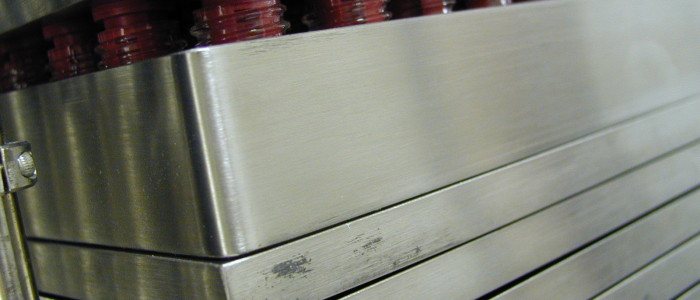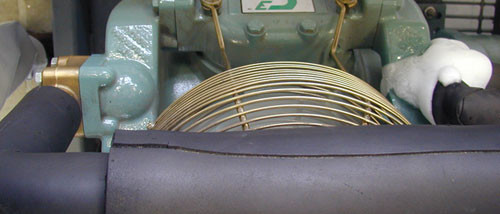Patient Risk Dependent Upon Lyophilizer Refrigeration Failure
We hope this communication is a resource to those of you who are experiencing inconsistent operation of your freeze drying systems and that this article saves you time and money.
The successful delivery of applied Lyo refrigeration technology reduces the risk associated with impromptu refrigeration failure that results in reduced product loss. Out of tune, and conventional plumbing set ups of lyophilizer refrigeration systems affect your company’s bottom line. Being aware of these variables may allow you to circumvent difficulties. Finding and repairing refrigeration anomalies requires an understanding of many related aspects of process, mechanical functionality, and proper piping and service technology.
Due to the threat of patient risk you need to be deeply concerned about the details of lyophilization [freeze-drying] system assembly. Sometimes subtle changes in freeze drying refrigeration performance can cause a cycle to fail. Time normally devoted to making product is now directed to answering quality assurance observations associated with cycle anomalies. This also affects the bottom line. Inventory levels may be dangerously lowered, products get thrown away, and profit is reduced dramatically when cycles fail.
When you look at mechanical refrigeration as applied to lyophilization and freeze drying, you may see conventional refrigeration compressors applied to an extraordinarily”outside of the box” application. One of our first observations is that the compressor specs do not encompass the actual operating range of a freeze dryer. Freeze dryers operate at lower temperatures, subject to wide variations, and one has to look for special refrigeration charts to actually see the suction and discharge pressures in this much extended range. You will not find the extended range chart in the compressor brochure! Freeze drying requires a much wider than the normal delivery range. Scores of components are used oussde or at the extremes of their normal operating ranges and temperatures. Consider that these components must enable safe usage between temperatures of 123 °C, [sterilization in place or “SIP” with steam, & afterwards, shelf cooling] condenser temperature to -75°C and even cycle times up to 10 days. Long cycle times result in accumulation of film coefficients, oil starving inside the compressor, and reduced performance. There’s probably a book or perhaps a whole career just in this lyophilization-freeze drying sub category, so, this short article can really only begin to explain some of the things to look for.
When considering reliability, it is interesting that systems powered by liquid nitrogen [LN2] are much more reliable than reciprocating or screw compressor systems. LN2 systems easily deliver the lowest temperatures needed for freeze-drying well within the temperature range of LN2 components.
The way the system is piped is not usually addressed during engineering of the system, as in most cases the piping is left to the assembly technician’s whim and fancy. It is very rare indeed that designers use three dimensional design practices and most times manufacturers do not have the appropriate equipment on hand to assemble the system in the best way for increased reliability.
Few manufacturers of production freeze drying systems incorporate the following into their design:
1. Unpainted refrigeration piping. Some suppliers’ refrigeration piping is painted. It’s said that a coat of paint covers a multitude of sins, but refrigeration piping should never be painted. Nor should refrigeration insulation be painted. Paint interferes with repairs, causing the joints to be “poisoned” and subject to immanent random failure. As the insulation expands and contracts, large black cracks appear, and when repairs to insulation are done, the machine looks “patched up.”
2. Good manufacturing practices for removing acid flux from around soldered joints. An example is the presence of green crusty deposits at soldered fitting joints, caused by incomplete removal of solder flux. Be aware also that oil deposits on the high side refrigeration piping joints or components are a sign of refrigerant leakage. Suction leaks are much harder to find because the lyophilization refrigeration system is almost always under vacuum conditions. The suction leak will cause high head pressure, and ultimately harms internal components like rod bearing surfaces, and discharge and interstage valves. Some deterioration takes place over time and causes slow failure; all deterioration can be catastrophic and random.
3. Use of heavy wall tubing: Make sure that all joints and piping use seamless type K copper piping elements [http://www.astm.org/DATABASE.CART/HISTORICAL/B280-02.htm] which are Sil-Fos copper soldered [http://www.silfos.com/products/catalog/Sil-Fos-orderby0-p-1-c-55.html]. Use inert gas purging and silver solder where there are dissimilar metal joints.
4. Elbow reduction: Eliminate all use of elbows and use only large radius bends especially in suction tubing. This will require pre-forming tubing, and or having access to some large CNC forming machinery [http://www.machinetools.net.tw/metal/taiwan_cnc_tube_bending.htm ].
5. Replacement of ferrule type connections wherever possible. Eliminate as many threaded refrigeration connections as possible, especially on any suction side device.
6. Use of helium leak checking piping system when warm and cold for leaks as part of the standard refrigeration QA delivery procedures on new system. What this means is that the manufacturer uses a helium mass spectrometer connected to the refrigeration system. The system is then slowly, and methodically subjected to a spray of helium gas over its entire surface. When the helium is forced into the refrigeration piping at a leak point, the mass spectrometer detects it and makes a sound or flashes a light. The leak can then be pinpointed, repaired and rechecked. Before charging with refrigerant, make sure technicians use Pirani type vacuum gauges for testing the sealed system including the oil charged compressor, and that the system dryer strainers are heated to ensure that moisture is evacuated. This will help to ensure that all of the moisture and air is out of the system, even what is dissolved in the refrigeration oil. When doing repairs observe the evacuation procedure. Evacuation and purging may take up to 12 hours after a system is open and humidity and air have been in contact with inside piping surfaces. After charging use a refrigeration electronic leak detector, to ensure a leak free system.
7. Incorporation of replaceable core, high side filters [in bypass arrangement], with refrigerant gauge charging hose access. This allows “on the fly” servicing.
8. Designing special tools and procedures, using high quality valves and fittings [like Whitey or Swage-lock]. These special fittings are designed to eliminate threads which can be leak points. They are not usually supplied due to the high costs .of engineering and manufacturing. [See article for some background http://www.solvay-fluor.com/docroot/fluor/static_files/attachments/c_23_e.pdf]
Know the pressures on the suction, interstage, evaporator, oil pressure and discharge side at all the cycle stages of your freeze drying lyophilization systems. The pressures shown on the refrigeration gauges change depending upon which portion of the cycle is running. Check the pressures on a routine basis and trend the results: daily or weekly when new, then monthly,then quarterly when you are confident of operational stability. Trending allows you to see if the pressures are rising or falling over time, which is indicative of system leakage. Increasing head pressure can mean a suction leak that draws air into the system. Leakage will cause long and short term unexpected failures.
Be aware that what I discuss above about piping is mandatory for laboratory freeze dryers and must be done for any repair procedures. If expedient measures are needed to “get you through the crisis” make certain to do a proper repair as soon as possible. The assembly and repair of all freeze dryer refrigeration systems requires highly trained individuals. Local technicians trained in freeze drying systems are very desirable. Applewood Scientific can help your local technicians with hands-on training.
I have only seen programs addressing these technology deliverables in two manufacturers and only when specified. There are other equally important accommodations which Applewood Scientific can describe during consulting.
Another consideration, of course, is cost. Most acquisition programs in freeze drying are designed to get the competing manufacturers to provide systems at their lowest price and highest specifications which are mutually exclusive. This gives manufacturers the message that “bean counters” rule; therefore little attention is given to these higher cost details. The result is that most manufacturers do not quote higher cost items, because this will ruin their competitiveness. I suggest that one can invest the time and effort needed to choose a supplier who is creative enough to include “advanced refrigeration system implementation practices and components©” as an option in quotations, so that users can easily separate the high quality and robust design costs from the “base” equipment price. Earmark these options and include them in a must-have budget. Before actual work on the project begins implement a “change order” after the supplier is chosen.
This article has mentioned some of the many important lyophilizer refrigeration system requirements to consider when you are repairing or adding to your lyophilization freeze drying capacity. We are specialists in hands-on operation, lyophilizer refrigeration system operation, and trouble shooting. We are also experts at managing and executing lyophilizer factory acceptance and freeze dryer site acceptance testing of a new freeze drying system.
Applewood Scientific is also a Project Partner in North America [USA and Canada] of the world’s largest manufacturer of pharmaceutical freeze drying and auto loading systems. We can supply pricing quotations and technical information such as responses to your User Requirement Specifications,and layout drawings. We can also answer all of your questions concerning pilot scale, production scale, and mass production scale freeze drying systems, either manually or auto loaded via row-by-row and by automatic guided vehicle.
If you want the “rest the story” contact us at [845-883-5766] or at freezedryingexpert@gmail.com and let’s discuss how Applewood Scientific can help you with your next project.



